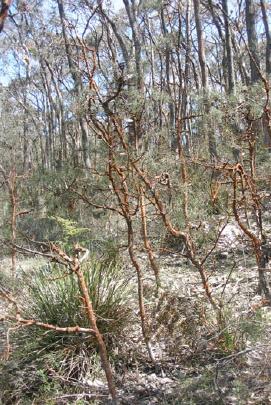Midlands Heathy Woodland (EVC 48-13)

Wombat Heathy Woodland (photo by Murray Ralph)
In the Wombat Forest, Heathy Woodland occurs on the top of dry ridges in the higher rainfall areas (900-1100mm), at altitudes of 600-830m above sea level. Soils are very fine white clay that are nutrient poor. The overstorey is dominated by Broadleaf Peppermint (Eucalyptus dives), which grows in a woodland form. Other Eucalypts that may also be present include Messmate (Eucalyptus obliqua) and Narrow-leaf Peppermint (Eucalyptus radiata). Understorey trees are usually lacking. A dense shrub layer of ‘heathy’-type species usually dominates the understorey. These shrubs tend to have leaves that are narrow, small, stiff and/or have sharp tips (ericoid is the botanical term for these types of leaves).
Common medium-sized shrubs include Dagger Wattle (Acacia oxycedrus), Bushy Hakea (Hakea decurrens), Prickly Tea-tree (Leptospermum continentale) and the low form of Silver Banksia (Banksia marginata).
Small shrubs include Rosy Baeckea (Baeckea ramosissima), Common Beard-heath (Leucopogon virgatus), Wombat Bush-pea (Pultenaea reflexifolia), Showy Parrot-pea (Dillwynia sericea) and Bundled Guinea-flower (Hibbertia prostrata). The climber Slender Dodder-laurel (Cassytha glabella) can be found growing intertwined with these shrubs.
Groundflora species include Common Hovea (Hovea heterophylla), Common Raspwort (Gonocarpus tetragynus), Tall Sundew (Drosera peltata ssp. auriculata) and Hairy Pennywort (Hydocotyle hirta).
Common grasses, rushes and sedges include Forest Wire-grass (Tetrarrhena juncea), Grey Tussockgrass (Poa sieberiana), Spiny-headed Mat-rush (Lomandra longifolia), Common Rapier-sedge (Lepidosperma filiforme) and Curly-wig (Caustis flexuosa). Lichen and mosses are also common. The fern Austral Braken (Pteridium esculentum) is also present and may dominate on sites that have experienced frequent fire.
All EVC are assigned a conservation significance based on the extent to which they have been cleared from their former range. Heathy Woodland is classified as being depleted. The main current threats to this EVC in the State Forest include climate change, fuel reduction burning, firewood collection, loss of ground logs and pest animals.
